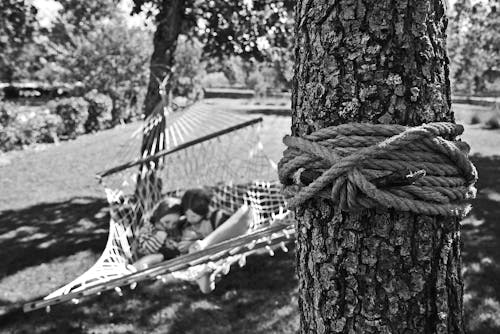
Chances are you have thought of getting a hammock to use in your garden. The imagery that it creates are lazy days between trees or lying by the sparkling waters of the pool. They are quite appealing with the variety of colours and designs they come in and invite the user to nap in the shade of a summer afternoon. Not all hammocks are created equal, and a rope hammock generally isn’t the type that you would take on a camping trip with you or leave out in the elements. But they are perfect for the more leisurely lifestyle, and we take a lot at what they’re all about.
What is a rope hammock?
A rope hammock is typically made from polyester or cotton ropes accompanied by spreader bars to help keep its shape and stops the user from flipping over. The loosely woven, flexible cotton-rope hammocks are considered traditional and allow air to flow through the open weave. While for some, fabric hammocks may be in more demand if used for more than just purely relaxing in the backyard, a cotton rope hammock has its own advantages.
Different types of rope hammocks?
Rope hammocks are considered to have a bohemian or classic look. Most people associate them with tropical locations and palm trees, and they usually come in two types:
- Nicaraguan Hammock – These are considered to be among the most beautifully adorned hammocks of the world. They are luxurious and tightly woven compared to other types of rope hammock. They are thick and heavy but give you a cozy, soft feeling that invites comfort and lazy afternoons. These are also recommended for sleeping on indoors.
- Mayan Hammocks – This type of rope hammock is a lot lighter than the Nicaraguan, and has a light, sprang woven webbing. Surprisingly, even though they are lightweight, they can hold a lot of weight. They are both aesthetically pleasing and durable but last longer if they are kept out of the weather. Like the Nicaraguan, the Mayan Hammock can also be used for sleeping indoors.
As mentioned previously, rope hammocks are made most commonly out of either cotton and nylon rope, and gaining popularity is polyester rope:
- Cotton Rope – The soft, natural cotton rope fibre has been used for hammocks for more than a century. While the cotton rope hammock is the most comfortable option, the user needs to be prepared to store it during the winter months out of the wet and snowy weather.
- Nylon Rope – Nylon is more slippery than other rope options and is subject to rot if left in the elements for a prolonged time. The fibres are strong, allow air to flow while still being comfortable. Like the cotton rope, it is best not to be left out continuously.
- Polyester Rope – This option last much longer than the cotton and nylon rope hammocks. It is less likely to mould or rot and interestingly has the same sort of feel that a cotton hammock does. Polyester rope hammocks are more likely to stand up to harsher environments than the more traditional cotton.
Spreader Bars
Most rope hammocks use a spreader bar. This pulls the rope tight, makes the hammock a lot easier for you to get in and out and is the recommended choice. The bars are located at each end of the rope hammock and can come in a variety of material. Wooden spreader bars can take a heavier load compared to other materials which are a key consideration when choosing your hammock.
While some people find that spreader bars cause the hammock to be too taught causing people to easily fall off, this has more to do with how tightly it has been put on and if amended these problems will be avoided.
Product Care
Caring for any hammock will help prolong its life, and when it comes to a rope hammock, it must be done right to avoid mould and mildew, especially if it’s made out of cotton. Like most hammocks, a simple hand wash with lukewarm water and a mild detergent is all that it requires.
If stained, use a soft brush to remove marks and ensure it’s thoroughly dry before packing away. For extra care, avoid leaving the hammock out in the elements for prolonged periods, especially if you live in a wet climate.
Pros and Cons of Rope Hammocks
Like all hammock types, a rope option has both pros and cons:
Pros
- Breathable
- Flexible
- Low maintenance
- Low cost
- Comfortable
- Ideal for hot weather
- Allows air to flow
Cons
- Takes longer to dry
- Susceptible to mould and rot
- Not as easily transported because of the spreader bars
- Can leave impressions on the skin
Tips For Getting The Most Out of Your Rope Hammock
When using a hammock, you want to get the most out of it, and this can be best achieved by using it correctly. While most of our tips may seem like common sense, a gentle reminder will ensure you avoid hurting yourself or experiencing other possible negative implications.
Tip 1:
If you are spending a lot of time in your rope hammock, we recommend taking a pillow and blanket with you, especially if you plan on sleeping in it overnight. Just like in bed, a pillow will help keep your spine aligned correctly.
Tip 2:
Hanging any hammock correctly is essential not only as a safety measure but so that it doesn’t abstain any damage also. For example, if you hang it taught, not only could you come straight off it when climbing in, but it could be causing the rope to become damaged over time, causing weakness.
Tip 3:
The angle is important. While it may seem obvious where your feet and head should be, in actual fact lying diagonally is a better option because it allows you to stretch out and give yourself more room in the hammock.
Rope Hammocks To Kick Back In
It’s important to remember if you are purchasing a rope hammock that it’s not designed for camping, hiking or wetter climates. They were created to be used around the pool, in palm trees, on warm summer days and cooler spring nights. We have chosen a few of our favourites which will have you well on your way to choosing the right hammock.
The Queen Resort Hammock is simply beautiful and perfect for lying back on warm sunny days and milder nights with a good book.
- 100% cotton
- Weight capacity 180kg
- Size – double
- Able to use outdoors
If it’s a simple set up for the outdoors, you want then this Army rope hammock is all that you need. Perfect for an outdoor expedition or roughing it in the backyard.
- Lightweight rope hammock
- Simple design
- Weight capacity 100kg
- Nylon rope
A rope hammock that looks and feels comfortable that can be used both outdoors and indoors.
- Weight capacity 100kg
- Suitable for 1 person
- Wooden spreader bars
- 100% cotton
It’s a reasonably simple hammock but doesn’t compromise on comfort. It blends naturally into the environment and will have you sitting back and relaxing in no time.
- 100% cotton
- Weight capacity 150kg
- Suitable for 1-2 people
- Suitable for outdoors
This rope hammock is luxurious not just because it has been hand weaved, but also because it’s a colourful delight of beauty that will brighten any outdoor space.
- 100% soft cotton
- Weight Capacity up to 400kg
- Plantation hardwood spreaders
- Decorative crochet edges
- Available in 5 colours

Questions
- Can a rope hammock be left outdoors all year round?
It isn’t recommended that you leave rope hammocks continuously outdoors. Prolonged exposure to the elements will shorten the hammock life, particularly if it is made out of cotton rope.
- Will my rope hammock stretch?
How long it stretches will depend on the type of material the rope is made out of. Generally, it can stretch anywhere from 30cm to 60cm.
- Are rope hammocks comfortable?
Yes! These hammocks are among the most comfortable you can get. Comfort is what these hammocks promise as their main aim is for relaxation.
- Can a mosquito net be used with a rope hammock?
Rope hammocks are not designed for using mosquito nets. They are more of a recreational type of hammock rather than one you would taking camping or bush walking.
- How do I know if a rope hammock is right for me?
The best way to determine what hammock is right for you is by deciding what you think you will use your hammock for, how often and for how many people at a time. This will help you decide on the weight that you need and whether it’s suited to your purpose. If you think that you may want to take it camping with you, then a rope hammock is unlikely to be suitable, and you will need to explore other options.